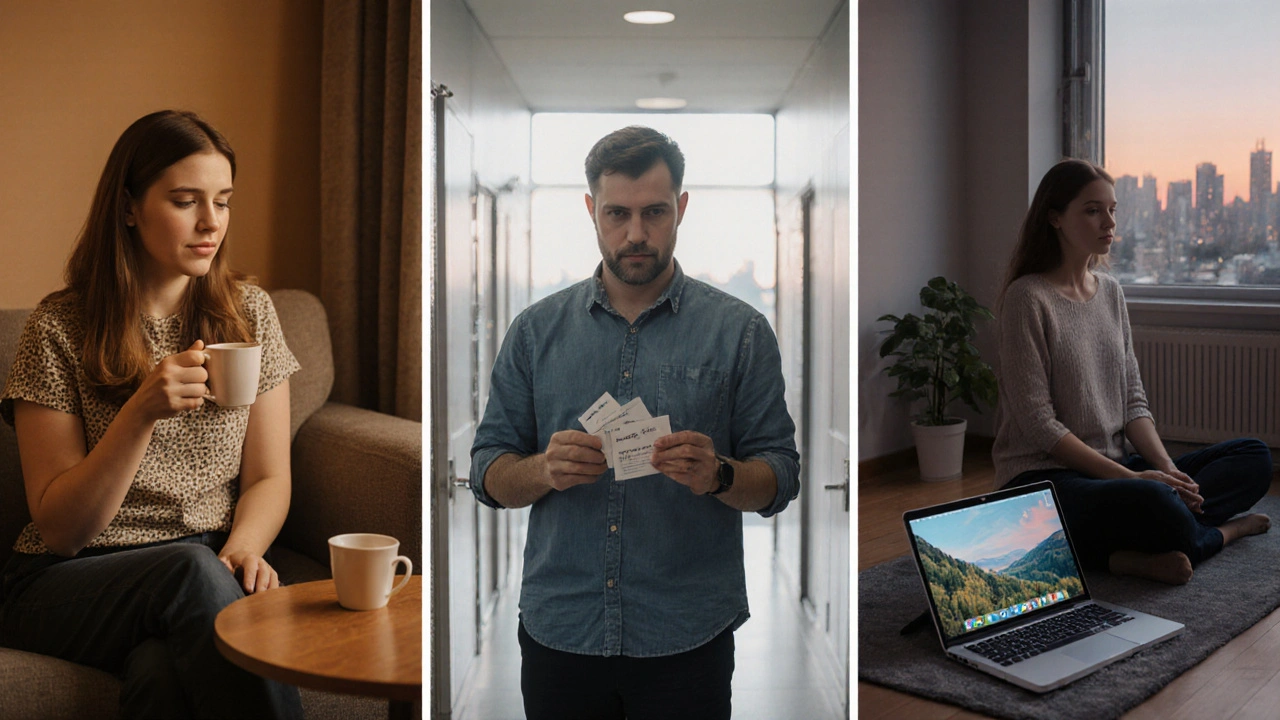
Health Anxiety Coping Strategy Selector
Recommended Strategy:
Cognitive Behavioral Therapy
Identify and reframe catastrophic thoughts through structured thinking patterns and behavioral experiments.
Effectiveness: Meta-analysis (2022) shows 70% reduction in symptom severity
Personalized Action Plan:
- Step 1: Write down your top three health fears
- Step 2: Rate each fear on a 0-10 anxiety scale
- Step 3: Choose one evidence-based strategy
- Step 4: Commit to a 30-day trial with daily logging
- Step 5: Review progress weekly
Living with health anxiety is a daily battle that many people don’t see coming. Health anxiety, also known as illness anxiety disorder, is the persistent fear of having a serious illness despite medical reassurance. The condition can feel invisible to outsiders, yet it dominates thoughts, actions, and even relationships. Below are real‑life stories, practical coping tools, and guidance on when to seek professional help.
What Health Anxiety Looks Like in Everyday Life
Imagine checking your temperature three times a day, Googling every minor ache, and postponing social plans because you’re convinced a cough means cancer. That’s the reality for many. The anxiety a heightened state of worry that triggers physical and mental symptoms fuels a loop: worry → physical sensation → more worry. Over time, the brain starts treating harmless bodily signals as red flags.
Real Stories From People Who’ve Been There
- Emma, 32, teacher: “I spent a year avoiding the doctor because every test result felt like a hidden clue. It wasn’t until my partner pushed me to talk to a therapist that I finally learned to calm the endless “what‑ifs.””
- Jason, 45, electrician: “After a minor chest tightening, I booked three specialists in a week. It cost me $2,000 and left me more anxious. When I started cognitive behavioral therapy a structured talk therapy that challenges unhelpful thoughts, the panic started to fade.
- Sofia, 27, graphic designer: “Mindfulness meditation felt too “new‑age” at first, but a five‑minute daily practice helped me notice the difference between a real symptom and a fear‑driven sensation.”
These narratives show that health anxiety doesn’t follow a single script. Each person discovers what works for them-often a mix of professional help, self‑care habits, and community support.

Key Coping Strategies - How Real People Made Progress
Below is a quick‑look comparison of the three most common approaches. Choose the one that feels right for you, or blend them for a personalized plan.
| Strategy | Core Idea | Typical Time Commitment | Evidence of Effectiveness |
|---|---|---|---|
| Cognitive Behavioral Therapy (CBT) | Identify and reframe catastrophic thoughts | Weekly 45‑minute sessions + homework | Meta‑analysis (2022) shows 70% reduction in symptom severity |
| Mindfulness Meditation | Observe sensations without judgment | 5‑20 minutes daily | Randomized trial (2021) found 45% drop in health‑focused rumination |
| Medication (SSRIs) | Balance brain chemicals that amplify worry | Daily pill, physician monitoring | Clinical guidelines (2023) recommend when anxiety is severe |
None of these methods are magic bullets. Success often comes from consistency and pairing the technique with lifestyle tweaks.
Lifestyle Tweaks That Complement Professional Care
- Support groups peer‑led gatherings where members share experiences and coping tips: Hearing that you’re not alone reduces isolation and provides practical ideas.
- Medical professionals doctors, psychologists, or psychiatrists who can evaluate and treat health anxiety: A clear diagnosis validates your concerns and opens pathways to treatment.
- Panic attacks sudden surges of intense fear that often accompany health anxiety can be diffused with grounding techniques-e.g., the 5‑4‑3‑2‑1 sensory exercise.
- Somatic symptoms physical sensations that feel real but are amplified by worry should be tracked in a simple log to separate patterns from catastrophizing.
- Stress management practices like regular exercise, adequate sleep, and balanced nutrition lowers overall anxiety levels, making health‑focused fears less sticky.
Implementing even one of these habits can shift the balance from fear to calm.
When to Seek Professional Help
Most people can manage mild health anxiety with self‑help tools, but look for these red flags that signal a need for professional intervention:
- Daily preoccupation consumes more than two hours.
- Medical appointments become costly or disruptive.
- Physical health deteriorates because you avoid exercise or proper nutrition.
- Relationships strain due to repeated reassurance‑seeking.
- Thoughts turn into compulsive checking rituals (e.g., measuring pulse every hour).
If any of these sound familiar, schedule an appointment with a mental‑health specialist. A qualified therapist can tailor a treatment plan, often blending CBT, mindfulness, and, when appropriate, medication.
Building Your Personal Recovery Roadmap
Here’s a simple step‑by‑step guide you can adapt right now:
- Write down the top three health fears that dominate your mind.
- Rate each fear on a 0‑10 anxiety scale.
- Choose one evidence‑based strategy (CBT worksheet, 5‑minute mindfulness, or a brief doctor visit for reassurance).
- Commit to a 30‑day trial, logging your anxiety score each day.
- Review progress weekly: note any drop in scores or new coping tricks.
- If improvement stalls, reach out to a medical professional or join a support group.
Remember, recovery isn’t a straight line. Some days you’ll feel ahead, others you’ll slip back. The roadmap simply keeps you moving forward.
Resources You Can Trust
- Australian Psychological Society - “Understanding Illness Anxiety Disorder” (PDF guide)
- Mind (UK) - free CBT worksheets for health anxiety
- Headspace - guided mindfulness sessions tailored for worry
- Local health‑care provider directories - find a therapist experienced in anxiety disorders
- Peer‑run online forums (e.g., r/HealthAnxiety on Reddit) - read more personal stories like Emma’s and Jason’s
These tools give you factual information, practical exercises, and community support-all essential ingredients for lasting change.
Frequently Asked Questions
Can health anxiety turn into a real medical condition?
Health anxiety itself doesn’t cause diseases, but the stress it creates can weaken the immune system and trigger real symptoms like headaches or stomach upset. Treating the anxiety reduces these secondary issues.
Is it normal to still worry after seeing a doctor?
Yes. Even after a clean bill of health, the mind may cling to doubt. That’s why ongoing strategies-like CBT thought records-are crucial to reshape the worry pattern.
Do I need medication if I’m already doing therapy?
Medication isn’t mandatory for everyone. It’s typically reserved for moderate‑to‑severe cases where anxiety hampers daily functioning. A psychiatrist can assess whether SSRIs or another option would help alongside therapy.
How can I talk to friends or family about my health anxiety?
Open up about the specific thoughts that trouble you and explain that reassurance‑seeking is part of the condition. Ask them to limit repeated check‑ins and instead support you in using your coping tools.
Are there quick‑relief techniques for a sudden panic attack?
Try the 5‑4‑3‑2‑1 grounding exercise: name five things you see, four you can touch, three you hear, two you smell, and one you taste. The sensory shift breaks the anxiety cycle within minutes.
Living with health anxiety is tough, but you don’t have to navigate it alone. Real people have moved from constant fear to calm living by mixing therapy, mindfulness, and community support. Start with one small step today and watch the pattern change.





